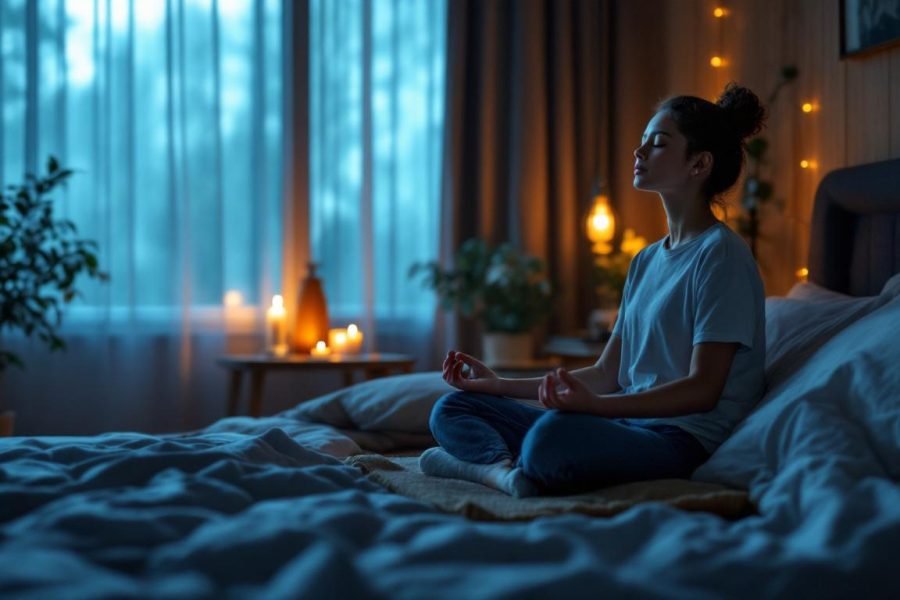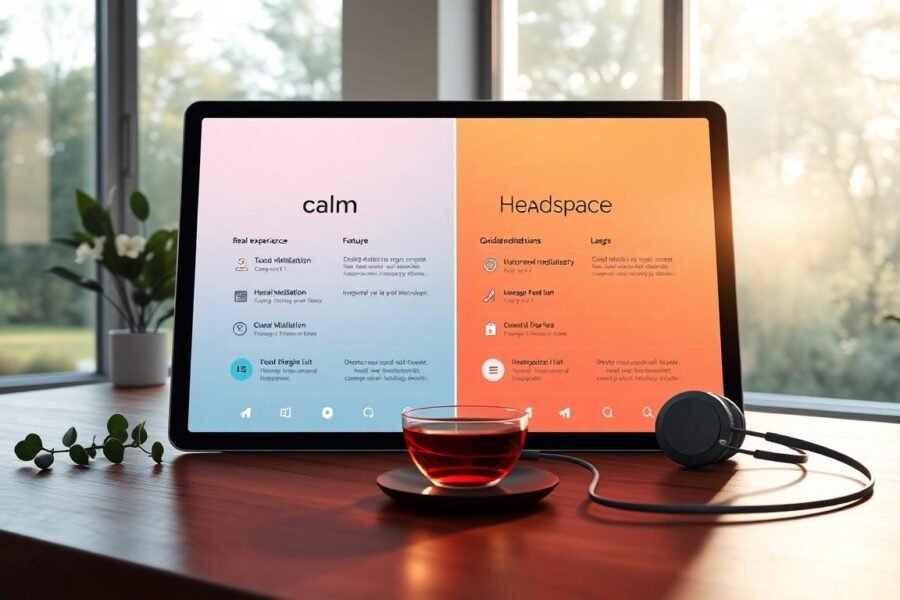Every student knows the weight of a routine full of tasks, deadlines, and demands. Between exams, assignments, and responsibilities even outside the classroom, the mind becomes overloaded, and even sleep loses its place in the schedule. This constant tension, coupled with endless distractions, increases stress and diminishes mental clarity.
With so many pressures, finding a moment to pause seems impossible. Meditation shows that there is, indeed, a simple and beneficial path, without promising miracles. Practicing for a few minutes already helps calm the mind, increase focus, and reduce that accumulated stress. Those who adopt meditation notice real changes in their routine: clearer thoughts, calmer reactions, and a feeling of lightness even in the most difficult weeks.
What Happens in the Mind of a Meditator

Meditation causes changes that go beyond external silence. By creating a space of attention, it acts directly on mental patterns, bringing a greater understanding of one’s own thoughts and emotions.
Those who incorporate the practice soon notice the beginning of an internal restructuring: thoughts seem to organize themselves like clouds dispersing after a storm, revealing a clearer and more welcoming sky for new ideas.
Both the brain and body respond to meditation with real signs of relief and balance, which is evident in reports from students who discovered in this practice a true anchor in days of pressure.
How Mindfulness Reduces Negative Thoughts
Mindfulness transforms our relationship with a restless mind. When I practice mindfulness, I position myself as a spectator of thoughts, no longer a hostage to them. This creates a sense of lightness, as if a mental fog begins to dissipate little by little.
Instead of dwelling on the same negative thoughts — like that self-criticism after a difficult exam — the practice encourages observing what arises without judgment. Gradually, I realize that I can restructure my view of situations: Instead of “I can’t,” “it was difficult, but I learned” emerges. The feeling of failure loses its strength and makes way for acceptance and kindness towards oneself. Rumination decreases because the focus is on the moment, not on past mistakes or future worries.
The image that comes to mind is one of clarity, like diving into clear water after days of rain. Meditating doesn’t “erase” bad thoughts, but it creates space to reorganize them, making the mind lighter and bringing inner peace even during exam weeks or assignment deadlines.
From Nerves to Relaxation: The Body Feels It Too
The transformation isn’t just in the head. The body responds to meditation with visible signs of relaxation and well-being, something already evidenced by studies with students from various areas. When I practice mindfulness, I feel my breathing slow down, my heart beat more calmly, and a comfortable warmth throughout my body. Research says the same: regular meditation practice reduces cortisol levels (the stress hormone), decreases heart rate, and improves nervous system balance. This translates to:
- Better quality sleep.
- Fewer headaches or muscle tensions.
- More energy to study and live the day.
Empirical reports show students who, after a few weeks of practice, feel less anxiety before evaluations and greater ease in maintaining concentration. It’s as if the body thanks each pause, recharging energies in a genuine way.
Meditating, then, is like offering rest to the body and mind amidst the accelerated pace of academic life. Feelings of lightness and well-being are not just pretty words: they appear in the small details of daily life, renewing how I deal with the challenges of being a student.
Meditation and Mental Clarity for Studies

The feeling of studying with a scattered mind is like trying to fish in a turbulent river, where nothing becomes clear. For me, meditation brought the opposite: silence in thought, clarity in decisions, and a focus that once seemed impossible. By practicing regularly, I felt not only less anxiety but also greater ease in remembering what I studied and creativity even in moments of blockage. These direct transformations in the study routine make all the difference in exams, long readings, and academic paper production.
Focus on Studies in Times of Distraction
Maintaining attention with so many invitations around (cell phone, notifications, conversations) is one of the big challenges of studying today. I know well what it’s like to sit down to review for a test and end up falling into the endless scroll cycle on social media. At these times, I learned that conscious breathing becomes a true ‘anchoring point’ to avoid being carried away by the current of distractions. Here are some techniques that make it easier:
- Conscious breathing: I stop, close my eyes, inhale counting to four, hold for two, and exhale counting to six. Repeating this cycle a few times calms my mind, brings focus back, and diminishes mental noise.
- Short study blocks: I divide study sessions into 25-minute periods (Pomodoro technique), taking mini-breaks to stretch and breathe deeply.
- Remove digital stimuli: I leave my phone on airplane mode or out of reach. Just reducing the number of notifications already increases my concentration.
- Mindfulness to content: I take a minute before starting any reading to breathe deeply and remember the goal of that task. This makes the brain associate that moment with total attention.
Regular practice of these techniques requires nothing more than consistency and willingness. It’s like training a muscle: the more I practice, the less I am distracted by surrounding noises or the digital anxiety of notifications.
Memory and Cognitive Flexibility: How They Improve with Practice
Anyone who has ever gone blank during an exam or forgotten simple things even after studying for hours understands the frustration. With meditation, I perceive that the brain gains space to organize information without so much background noise, as if throwing away unnecessary computer files. Some practical effects I felt and that researchers also point out:
- Improved short and long-term memory: After including simple daily meditation, I remember details of texts and formulas with more clarity, even days after studying.
- More creativity in problem-solving: Problem situations or essay topics stopped being a blockage. My mind becomes more open to finding solutions, making connections, or proposing innovative ideas.
- Easier access to information: During exams, I notice that I retrieve answers from memory without as much nervousness. Stress decreases, and this facilitates logic and reasoning in more complex tasks.
- Greater cognitive flexibility: Changing subjects, adapting reasoning between different subjects, and dealing with unforeseen events becomes less exhausting. I feel like I can jump from one reading to another without losing the thread.
The connection between creativity and stress reduction is also clear to me. When pressure lowers, thought flows, and ideas appear without so much blockage. This is visible in written assignments, presentations, and even when interacting in groups. A relaxed mind is more creative and can find alternatives to academic challenges.
With constant practice, the benefits extend to the entire student routine: studying becomes a lighter, more productive, and even pleasurable moment. Meditating is not wasting time; it’s saving mental energy for what truly matters.
Stress Under Control: Emotional Regulation at Your Fingertips

Living under pressure has become routine for students. Anxiety before exams, demands for increasingly better grades, constant comparison with other classmates. Simple daily situations seem like endurance tests, and the mind ends up being on alert all the time. In this scenario, I learned that regulating emotions is less a rare skill and more a daily training, much more accessible than we usually imagine. Meditation, combined with self-knowledge, shows practical ways to deal with this internal roller coaster. It’s not about eliminating stress completely, but about understanding and embracing what we feel, bringing closer what seemed out of reach.
Building Resilience in the School Routine
I don’t romanticize the daily challenges of students. Each week brings new trials: that anxiety that tightens before an important evaluation, the constant worry about keeping grades in order, or the feeling of failure on days of low grades. No one chooses to go through this, but I learned that the strength to face all this doesn’t come out of nowhere. It builds, little by little, in small confrontations.
When I feel nervousness coming before an exam, I usually resort to conscious breathing. Stopping for a few minutes, focusing on the air entering and leaving, helps my body realize that the danger is not real. In this way, I can think more clearly and face the challenge without self-sabotage. I don’t erase fear, but I don’t let it grow to the point of dominating my actions. Resilience, in practice, arises from these small and repeated strategies:
- Recognizing what I feel, without hiding or disguising emotions.
- Talking to someone trustworthy, whether a friend or advisor, to share the anxieties of the moment.
- Remembering small past victories. I’ve overcome difficult phases before and I can do it again.
- Using meditation as a tool to create an internal space of calm between challenges.
These steps were fundamental in helping me not get lost in external and internal demands. Resilience, for me, is accepting that falling is part of it, but also getting up, without forcing myself to seem unshakable.
Self-Compassion and Mental Health for a Lighter Life
Discovering self-compassion changed my relationship with myself. I began to understand self-compassion as that friendly inner voice that embraces me when I make mistakes or fail, instead of blaming or criticizing even more. I see in colleagues, and in myself, how self-compassion helps lighten the mental burden of academic daily life. Instead of treating failures as the end of the world, I view them as opportunities for learning. Self-compassion has three simple pillars:
- Kindness to oneself: Saying phrases to yourself like “it’s okay not to be perfect,” with the same tone you would use for a dear friend.
- Feeling of shared humanity: Remembering that making mistakes, feeling fear, or being overwhelmed is part of being human; I’m not the only one going through this.
- Mindfulness: Looking at the present moment without exaggerating or ignoring feelings, accepting what is happening now.
When I put these principles into practice, I notice real changes:
- The decrease in self-judgment, that demanding inner voice.
- Daily stress loses some of its strength; my self-esteem grows.
- I am less stuck in rumination and recurring negative thoughts.
These effects appear both in studies and in reports from those who practice meditation regularly. They don’t turn anyone into an emotional superhero, but they make daily life weigh less on the back and mind. Self-compassion and mental health are much more connected than I imagined; taking care of myself reflects in how I deal with everything around me.
My routine may remain demanding, but with self-compassion and small pauses for conscious breathing, I stop carrying the burden of performance and expectations alone. It is indeed possible to build a lighter and healthier path, even during the most tense periods.
Conclusion
I discovered that meditating doesn’t require complicated rituals or rigid rules. Just a few minutes of pause and attention are enough to feel the difference. Every student finds their own rhythm, whether through conscious breathing, being present during a task, listening to their body, or simply giving themselves permission to breathe without guilt.
Experimenting with small daily practices can be the first step to gaining clarity and lightness, without the demand for perfection. The important thing is to respect your own time, test, and create a routine that makes sense for you, whether during a break between classes or before bed.
I know firsthand how the mind calms and stress loses its power with simple acts of self-care. The invitation is made: allow yourself to gradually discover how meditation can transform your routine. Share your experience, exchange ideas, and, if you wish, inspire other students on this same path. Thank you for reading this far. May your next days be lighter and clearer.






Deixe um comentário